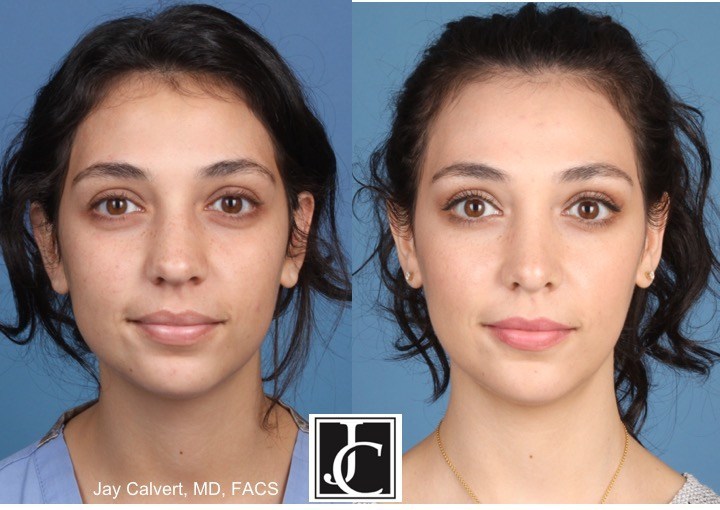Not known Facts About Nose Job Austin
Table of ContentsThe 25-Second Trick For Rhinoplasty Surgery AustinIndicators on Rhinoplasty You Need To KnowRhinoplasty for Dummies
Picture 4. Nasal bulge excision: The black delineation shows the preferred nose-reduction outcome: a straight nose. The nasal bulge is bone (red) above the scalloped grey line, and cartilage (blue) below the scalloped grey line. The cosmetic surgeon cuts the cartilage portion of the hump with a scalpel, and chisels the bone portion with an osteotome (bone chisel).Rhinoplastic instruments: Bone-scraping rasps, of different grades and types, that the cosmetic surgeon uses to refine the corrections needed to produce a brand-new nose. In plastic surgical praxis, the term primary nose surgery denotes an initial (first-time) reconstructive, practical, or aesthetic corrective treatment. The term secondary nose surgery represents the revision of a failed nose job, an incident in 520 per cent of rhinoplasty operations, for this reason a modification nose job.
Although many modification rhinoplasty procedures are "open method", such a correction is more technically complicated, typically due to the fact that the nasal assistance structures either were warped or destroyed in the main nose job; therefore the surgeon should re-create the nasal support with cartilage grafts harvested either from the ear (auricular cartilage graft) or from the rib cage (costal cartilage graft).
In reconstructive nose surgery, the problems and defects that the cosmetic surgeon encounters, and should bring back to regular function, kind, and look include broken and displaced nasal bones; disrupted and displaced nasal cartilages; a collapsed bridge of the nose; congenital defect, trauma (blunt, permeating, blast), autoimmune condition, cancer, intranasal drug-abuse damages, and failed main nose job outcomes.
When cartilage is interfered with, suturing for re-suspension (structural assistance), or using cartilage grafts to camouflage an anxiety allow the re-establishment of the regular nasal contour of the nose for the patient. When the bridge of the nose is collapsed, rib-cartilage, ear-cartilage, or cranial-bone grafts can be utilized to restore its structural stability, and therefore the visual continuity of the nose.

Not known Incorrect Statements About Austin Rhinoplasty
Surgically, the borders of the nasal subunits are perfect places for the scars, where is produced a remarkable aesthetic outcome, a fixed nose with matching skin colors and skin textures. Nasal skeleton Therefore, the effective rhinoplastic result depends completely upon the particular upkeep or restoration of the structural stability of the nasal skeleton, which comprises (a) the nasal bones and the rising procedures of the maxilla in the upper 3rd; (b) the paired upper-lateral cartilages in the middle 3rd; and (c) the lower-lateral, alar cartilages in the lower 3rd (rhinoplasty).
The Web Site paired alar cartilages configure a tripod-shaped union that supports the lower third of the nose. The paired median crura conform the central-leg of the tripod, which is connected to the anterior nasal spinal column and septum, in the midline. The lateral crura make up the second-leg and the third-leg of the tripod, and are connected to the (pear-shaped) pyriform aperture, the nasal-cavity opening at the front of the skull.
the nasal lining A thin layer of vascular mucosa that adheres securely to the deep surface of the bones and the cartilages of the nose. Said thick adherence to the nasal interior limits the movement of the mucosa, consequently, only the smallest of Visit Your URL mucosal problems (< 5 mm) can be sutured primarily.

Additionally, relating to scarrification, when compared to the skin of other facial areas, the skin of the nose produces fine-line scars that generally are unnoticeable, which allows the cosmetic surgeon to strategically hide the surgical scars. Concepts The technical principles for the surgical restoration of a nose stem from the essential personnel principles of plastic surgery: that the applied procedure and strategy( s) yield the most satisfying practical and aesthetic result.
Nonetheless, the physician-surgeon and the rhinoplasty patient should abide the truth that the rebuilded nasal subunit is not a nose proper, but a collagen- glued collageof forehead skin, cheek skin, mucosa, vestibular lining, nasal septum, and pieces of ear cartilagewhich is perceived as a nose just since its contour, skin color, and skin texture are true to the original nose - rhinoplasty austin tx.
More About Nose Job Austin
1. 0 metre). Yet, such a visual result recommends the application of a more intricate surgical approach, which requires that the surgeon balance the client's needed nose surgery, with the patient's visual ideal (body image). In the context of surgically rebuilding the client's physiognomy, the "regular nose" is the three-dimensional (3-D) template for changing the missing part( s) of a nose (aesthetic nasal i thought about this subunit, visual nasal segment), which the cosmetic surgeon re-creates using company, malleable, designing materialssuch as bone, cartilage, and flaps of skin and of tissue.
To effect a total nasal reconstruction, the design template may derive from quotidian observations of the "typical nose" and from photos of the client before she or he suffered the nasal damage (rhinoplasty austin). The surgeon replaces missing out on parts with tissue of like quality and quantity; nasal lining with mucosa, cartilage with cartilage, bone with bone, and skin with skin that finest match the native skin color and skin texture of the damaged nasal subunit.
In addition, regardless of its notable scarring propensity, the nasal skin flap is the prime factor to consider for nasal reconstruction, since of its greater verisimilitude. The most efficient nasal restoration for repairing a defect (injury) of the nasal skin, is to re-create the whole nasal subunit; thus, the wound is enlarged to understand the entire nasal subunit.